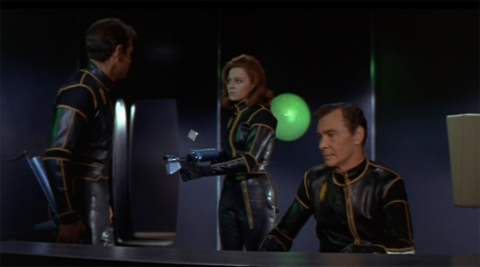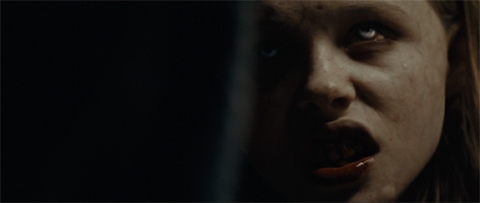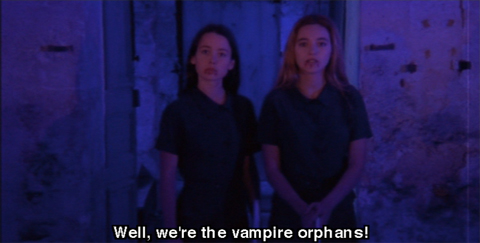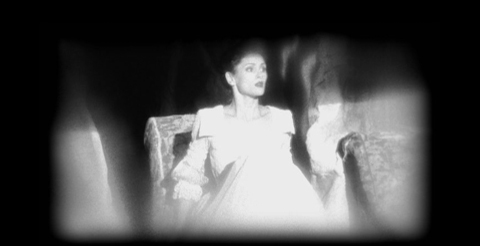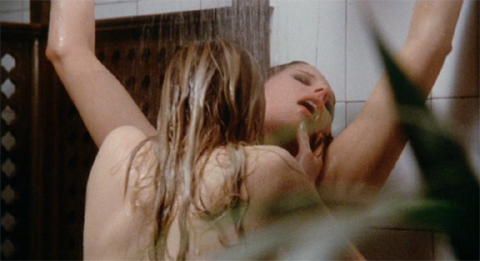Vampire films take the classic monster story and make the monster alluring, sexy, and seductive. We used to get more of this when people were more afraid of demons and satyrs and other foul beasts coming out of the woods to spoil the women. The willingness with which victims often fall prey to their attackers can be a chilling, psycho-sexual drama of coercion and at the same time an expression of lustful desire. I tried to pick a broad range of vampire films this week to see how the themes of seduction and horror intertwined. Some of them get it more right than others.
The Films
Planet of the Vampires (1965) dir. Mario Bava
Let Me In (2010) dir. Matt Reeves
Two Orphan Vampires (1997) dir. Jean Rollin
Near Dark (1987) dir. Kathryn Bigelow
Dracula: Pages From a Virgin’s Diary (2002) dir. Guy Maddin
Vampyres (1974) dir. José Ramón Larraz
Nosferatu (1922) dir. F.W. Murnau
Planet of the Vampires
Beware, this film features no actual vampires. It doesn’t even have creatures that are vampire-like, though the monsters do ultimately possess their prey. Mario Bava’s campy sci-fi thriller predates the Star Trek series by a year which probably isn’t long enough that it could be claimed as an inspiration, but the sets, costumes, spaceships, and acting are all spot-on predictors of what Star Trek would become. The film also bares a striking resemblance to Alien. In it, a derelict ship lures unsuspecting space travelers to an inhospitable rock where they are set upon by parasitic lifeforms. Planet of the Vampires is like a perfect bridge between Forbidden Planet and Alien, actually. It still plays by those “square-jawed space captain saves the day” kind of rules but it also wants to go somewhere darker and more horrific. With a limited budget and actors more suited to TV melodrama than a realistic thriller, I can’t say it quite gets there, but it’s a movie that is at least fun and is heading in the right direction.
Let Me In
Taken on its own, Let Me In is a far more interesting and daring vampire movie than almost anything else that has come out of an American studio in ages. The transposition of the very adult nature of the vampire’s seduction to a more innocent age is chilling. The bloodthirsty attacks are brutal and the kidnappings (successful and botched) are handled with the right mixture of slasher film violence and tragic clumsiness. The film uses typical horror movie cues and deep rumbling sounds to effectively ramp up the tension and to signify when things are going to get bloody, and I can see how a typical Friday night megaplex audience would find the movie full of effective scares. But none of this is anything that Matt Reeves brought to the table. He makes his own film, replacing the cool blues and whites of the original with warm yellows and reds and he gives Owen a particularly creepy scene that casts more doubt on his motivations than anything in the original. There are no CGI cats (thankfully) but that doesn’t mean that the CGI Abby couldn’t have used some more work. Reeves turns Abby’s full-on vampire mode into something grotesque which works in its own way. Still, nearly every aspect of the original film is simply more effective and more evocative. Every character moment in Let the Right One In leads to the perfectly inevitable and tragic ending–an ending that no matter how many times I see it still feels painful and sad. Let Me In just kind of arrives at the end without ever establishing the emotional toll that the relationship is going to take on Owen. But isn’t that the point of the story?
Two Orphan Vampires
The box art promised sapphic, blind, orphan vampires–too good to pass up, right? Unfortunately, the film from Jean Rollin is a complete bore. The two orphans are played by girls who are almost as bad at acting blind as Kerry Washington in the Fantastic Four films. Somehow they are only blind in the daylight, and at night they can stalk prey, kill dogs, and go on long walks where they reminisce about how they became vampires. The movie wouldn’t be quite so tedious if it indulged in the sex and violence that it hints at, but it’s far too tame to be any good. A good example: the two orphans have just killed a woman (off-screen) and they are feeling mischievous so they dare each other to stand naked outside the window of their new adoptive father. One asks the other to cover her in blood, they undress, hug, then there’s a cut to the window and a cut back to the girls standing next to each other with blood splashed on their chests. Then they just put their clothes back on and go home! I didn’t expect this to be a great work of art, but I somehow expected it to be a little sleazier.
Near Dark
Kathryn Bigelow’s modern Western meets Vampire film is a great example of genre tropes colliding successfully. We get shootouts, standoffs, a horse, a lasso, and dusty chases across the badlands, but we also get blood drinking, bathtub sleeping, night stalking, and the horrible affects of sunlight on undead skin. It begins with the perfect vampire seduction as an innocent (but horny) young cowboy is lured into the night by a sexy young woman. She bites him but doesn’t drain him and the rest of the film follows his struggle to join the vampire family or to somehow escape it. The Tangerine Dream score is pretty fantastic and Bigelow’s action scenes are nicely shot, especially the standoff in a shack where every bullet hole that pierces the wall adds another deadly ray of sunlight to the room. Lance Henriksen is worth the price of admission alone and as a bonus the film offers Bill Paxton doing a bloodier, angrier version of Chet!
Dracula: Pages From a Virgin’s Diary
Guy Maddin somehow translates a ballet performance of Dracula into an effective and lyrical film. The ballet lends itself to an exploration of the sensual side of the vampire mythos, so Maddin’s film naturally focuses on the beauty and grace of the vampire’s seduction and on the budding sexual desires of his victims. Maddin has turned the story into a meditation on the male fear of losing a woman to another man, and the horror comes from the notion that Dracula’s victims might be longing for the experience he can provide. Dracula’s seduction of Lucy seems aided by some kind of magic, but to the sexually awakened Mina, he needs merely to present the possibility of dark, uninhibited passion and she becomes conflicted. It’s a beautiful take on the classic and another fantastic feature from one of the most interesting directors working today.
Vampyres (aka Daughters of Dracula)
Now this is what I was looking for in a sleazy, lesbian vampire romp. This is, in every way, the film that Two Orphan Vampires should have been. A lesbian couple living (or un-living as it were) in an old mansion lure unsuspecting travelers in for copious amounts of wine, sex, and bloodletting. Movies just don’t feature women who look like this anymore and that’s a crying shame because Marianne Morris and Anulka Dziubinska are absolutely stunning and the film gives them plenty of opportunities to get it on with their victims and with each other. The sex is steamy, the violence is creepy and macabre, and the whole thing works as the revenge tale of two women who were gunned down, presumably because of their sapphic inclinations. I kind of loved this.
Nosferatu
Max Schrek’s Count Orlok is never sexy. He never uses sensual power to seduce his victims. In fact, the seduction is reversed for Nosferatu as the virginal Ellen reads that she can destroy him and his influence by tricking him into staying in her house past dawn. She’s curious about the vampire and she can’t help but read the book that she’s been forbidden to read, but that curiosity is ultimately what does Nosferatu in. Is this a canny reversal of the fear that a woman’s sexual urges will always lead to destruction (as presented in Dracula?) F.W. Murnau’s take on Dracula is a fantastic, paranoid tale about the dangers of foreigners and the need for quarantine. Orlok brings the plague with him on his black ship so his scourge affects not just the few lives that he seeks for sustenance but also the rest of the village that gets overrun by diseased rats. I’m glad that I saved this one for last since it reaffirmed the vitality of the vampire story, even in an age when we collectively roll our eyes at the ‘dark romance’ section of the bookstore.
Other Movie Weeks in 2011
Recent Westerns Week
Non-Godzilla Kaiju Week
Woody Allen Week
Secret Agent Week
Asian Action Week
